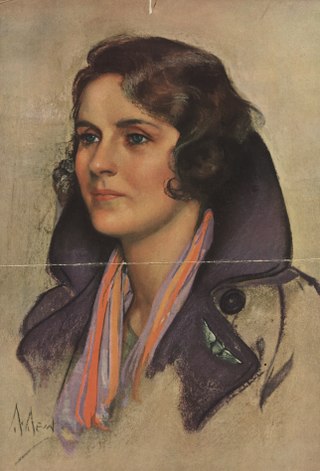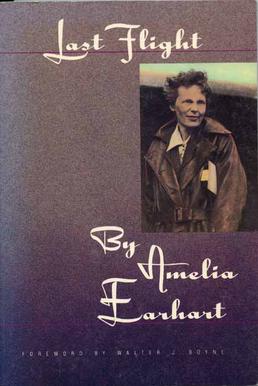
Howland Island is a coral island and strict nature reserve located just north of the equator in the central Pacific Ocean, about 1,700 nautical miles (3,100 km) southwest of Honolulu. The island lies almost halfway between Hawaii and Australia and is an unincorporated, unorganized territory of the United States. Together with Baker Island it forms part of the Phoenix Islands. For statistical purposes, Howland is grouped as one of the United States Minor Outlying Islands. The island has an elongated cucumber-shape on a north–south axis, 1.40 by 0.55 miles, and covers 1 square mile.

Amelia Mary Earhart was an American aviation pioneer. On July 2, 1937, Earhart disappeared over the Pacific Ocean while attempting to become the first female pilot to circumnavigate the world. During her life, Earhart embraced celebrity culture and women's rights, and since her disappearance, she has become a cultural icon. Earhart was the first female aviator to fly solo non-stop across the Atlantic Ocean and she set many other records; she was one of the first aviators to promote commercial air travel, wrote best-selling books about her flying experiences, and was instrumental in the formation of The Ninety-Nines, an organization for female pilots.

Frederick Joseph Noonan was an American flight navigator, sea captain and aviation pioneer, who first charted many commercial airline routes across the Pacific Ocean during the 1930s. As the flight navigator for famed aviator Amelia Earhart in their pioneering attempt at circumnavigating the globe, they disappeared somewhere over the central Pacific Ocean on July 2, 1937.
The Lockheed Model 10 Electra is an American twin-engined, all-metal monoplane airliner developed by the Lockheed Aircraft Corporation, which was produced primarily in the 1930s to compete with the Boeing 247 and Douglas DC-2. The type gained considerable fame as one was flown by Amelia Earhart and Fred Noonan on their ill-fated around-the-world expedition in 1937.

The Lockheed Model 12 Electra Junior, more commonly known as the Lockheed 12 or L-12, is an eight-seat, six-passenger all-metal twin-engine transport aircraft of the late 1930s designed for use by small airlines, companies, and wealthy private individuals. A smaller version of the Lockheed Model 10 Electra, the Lockheed 12 was not popular as an airliner but was widely used as a corporate and government transport. Several were also used for testing new aviation technologies.

Johan Adolf Pengel International Airport, also known as Paramaribo-Zanderij International Airport, and locally referred to simply as JAP, is an airport located in the town of Zanderij and hub for airline carrier Surinam Airways, 45 kilometres (28 mi) south of Paramaribo. It is the larger of Suriname's two international airports, the other being Zorg en Hoop with scheduled flights to Guyana, and is operated by Airport Management, Ltd./ NV Luchthavenbeheer.

USCGC Itasca was a Lake-class cutter of the United States Coast Guard launched on 16 November 1929 and commissioned 12 July 1930. It acted as "picket ship" supporting Amelia Earhart's 1937 world flight attempt, and was the last vessel in radio contact with her as she was supposed to be reaching Howland island in the Pacific. In 1941, it was transferred to the United Kingdom and served as a convoy escort in World War II as HMS Gorleston.

Ruth Rowland Nichols was an American aviation pioneer. She is the only woman yet to hold simultaneous world records for speed, altitude, and distance for a female pilot.

Last Flight is a book published in 1937 consisting of diary entries and other notes compiled by aviation pioneer Amelia Earhart during her unsuccessful attempt that year at flying solo across the Pacific Ocean. Her husband, publisher George Palmer Putnam, edited the collection which was published posthumously as a tribute to his wife.

Elgen Marion Long was a distinguished American aviator, author, and researcher who achieved numerous notable milestones in aviation. Among his impressive accomplishments, Long set fifteen aviation records, including a groundbreaking 1971 flight around the world over both poles, which earned him the FAI Gold Air Medal.

Amelia is a 2009 biographical film about the aviation pioneer Amelia Earhart. The film stars Hilary Swank as Earhart, and co-stars Richard Gere, Ewan McGregor, Christopher Eccleston and Joe Anderson. The film was directed by Mira Nair and based on The Sound of Wings by Mary S. Lovell. The film received predominantly negative reviews, with critics polarized over the performances and criticizing the film's story. It was also a box-office bomb, grossing $19.6 million against a budget of $40 million.

Flight for Freedom is a 1943 American drama film directed by Lothar Mendes and starring Rosalind Russell, Fred MacMurray and Herbert Marshall. Film historians and Earhart scholars consider Flight for Freedom an à clef version of Amelia Earhart's life story, concentrating on the sensational aspects of her disappearance during her 1937 world flight. The film's ending speculated that the main character's disappearance was connected to a secret mission on behalf of the U.S. government. As a propaganda film, the Japanese characters in Flight for Freedom were portrayed as devious and evil.
David Walter Jourdan is an author, founder of Meridian Sciences, and the co-founder and president of Nauticos, a deep ocean exploration company. He studied physics and engineering at the U.S. Naval Academy and Johns Hopkins University, and served as a U.S. Navy submarine officer during the Cold War. Jourdan and his Nauticos team have made a number of notable deep ocean discoveries, including the missing Israeli submarine INS Dakar in the Mediterranean and the Japanese aircraft carrier Kaga, sunk in the Battle of Midway. He has led two deep ocean expeditions in search of Amelia Earhart and Fred Noonan’s Lockheed Electra airplane in the ocean off Howland Island, the atoll Earhart and Noonan were attempting to find when they vanished. He has published several books, Never Forgotten: the Search and Discovery of Israel's Lost Submarine Dakar; The Deep Sea Quest for Amelia Earhart.; and The Search for the Japanese Fleet: USS Nautilus and the Battle of Midway.

Coast Guard Air Station Miami is an Air Station of the United States Coast Guard located at Opa-locka Executive Airport in Opa-locka, Florida. The station operates the HC-144 Ocean Sentry maritime patrol aircraft and the MH-65 Dolphin helicopter.

Amelia Earhart is a 1976 American biographical drama television film directed by George Schaefer and written by Carol Sobieski. It stars Susan Clark as Amelia Earhart, and John Forsythe as her husband, George P. Putnam.

Amelia Earhart: The Final Flight is a 1994 American biographical television film directed by Yves Simoneau, written by Anna Sandor, and starring Diane Keaton, Rutger Hauer and Bruce Dern. The film is based on the 1987 book Amelia Earhart: A Biography by Doris L. Rich, and depicts events in the life of Amelia Earhart, focusing on her final flight and disappearance in 1937, with her exploits in aviation and her marriage to publisher George P. Putnam being revealed in flashbacks. It aired on TNT on June 12, 1994.

Joan Merriam Smith was an American aviator, famous for her 1964 solo flight around the world, in which she became the second woman to complete the trip, by following the equatorial route attempted in 1937 by Amelia Earhart. In doing so she also became the first woman to fly a twin-engine aircraft around the world, and the first woman to fly the Pacific Ocean from west to east in a twin-engine plane. She died the following year when the plane she was piloting suffered structural failure and crashed in California.

Amelia Earhart: The Lost Evidence is a 2017 documentary broadcast by the US television network History that purported to have new evidence supporting the Japanese capture hypothesis of the disappearance of Amelia Earhart and Fred Noonan. Its main piece of evidence, a photograph purportedly showing the two still alive after their 1937 disappearance, was soon proven to have been published in 1935, and subsequent showings of the documentary were cancelled.

Linda (Dueler) Finch, also known as Linda Finch Doctor, is an American businesswoman, aviator, and aviation historian from San Antonio, Texas. Finch had 30 years of experience in the construction industry, making prefabricated buildings, and operating healthcare facilities. She began her career managing nursing homes in her twenties and owned several nursing homes in her thirties. Finch became a pilot and purchased an airplane that she used in her nursing-home business. She later added construction firms to her portfolio.
Speculation on the disappearance of Amelia Earhart and Fred Noonan has continued since their disappearance in 1937. The most likely explanation is that their airplane ran out of fuel, crashed in the ocean, and sank. Because there is no solid evidence of this, other theories have arisen. The fate of Amelia Earhart and Fred Noonan remain a subject of debate and continuing research.


















